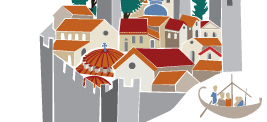Thessaloniki - Mystras: "Constantine XI Palaiologos"
On October 31st 1448 Emperor
John VIII died without an heir. His brother Constantine, who was then despot of
Mystra, ascended the throne. Legend has it that he was crowned emperor in the
capital of the despotate, in January 1449, but we can be sure that two months
later he travelled to Constantinople, where he was given a triumphant welcome. Constantine rose to the
throne at an absolutely critical time for the empire. Thessaloniki, the second largest city in Byzantium, had already been
under Ottoman rule for twenty years, after falling to forces under Murad II,
while the greater part of Macedonia
was in Turkish hands by the late 14th century. The only free state in the southern Balkans was the
Despotate of Mystras.
As a
despot Constantine
had showed great skill. By 1444 he had succeeded in rebuilding the Examilion
Wall at Corinth
and in recapturing Athens
and Thebes. The
following year his forces marched into Central Greece
and he himself reached Mount
Pindos, where Albanian
and Vlach populations joined forces with him. He made several attempts to curb
the power of the Venetians, who held Argos
and Nafplion on the east coast of the Peloponnese,
and Koroni and Methoni on the west. However, in November 1446 Murad II’s
cannons destroyed Examilion and his troops devastated the northern Peloponnese as far as Killini. Constantine and his
brother Thomas managed to escape with a handful of their troops, while the
Turks withdrew not long afterwards.
After
the fall of Constantinople the Ottomans
experienced great difficulty in advancing into the Peloponnese.
It was only in 1460 that Demetrius Palaeologus was forced to surrender Mystras,
and other cities put up fierce resistance. The residents of Monemvasia sought
the protection of Pope Pius the Second, finally surrendering the city to the
Venetians late in 1463. Since they did not wish to engage in war with Venice, the Ottomans did
not launch attacks against Methoni and Koroni, which only fell into their hands
in 1500, followed by Nafplion forty years later.
Trail stops catalog
Bibliography (2)▼
Comments (0)▼
New Comment▼






